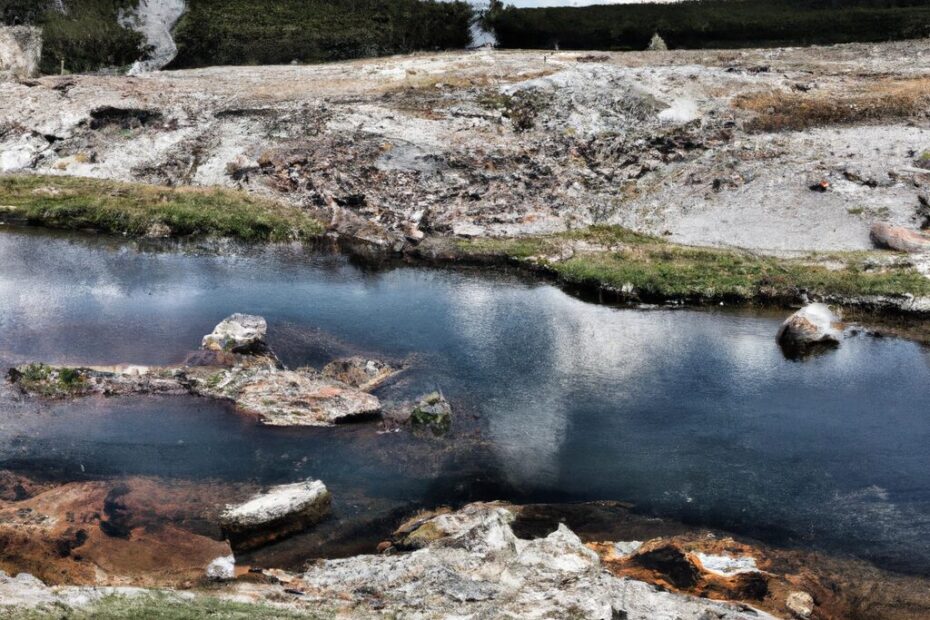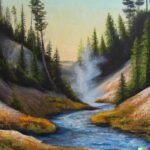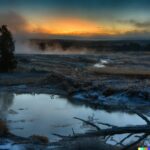Sawmill Geyser geological formations are a fascinating natural wonder that can be found in various parts of the world. These unique formations come in different shapes and sizes, and are the result of complex geological processes and erosion over time.
In this article, we will explore the characteristics of Sawmill Geyser formations and their significance in geological research and tourism. We will also discuss the factors that cause their formation, the different types of formations, and how we can work towards preserving these natural marvels for future generations.
So, let’s dive in and discover the incredible world of Sawmill Geyser geological formations!
What Are Sawmill Geyser Geological Formations?
Sawmill Geyser Geological Formations refer to the unique geological features found in Yellowstone National Park, including hot springs, geysers, and other hydrothermal formations.
The formations found in Yellowstone National Park play a crucial role in comprehending the park’s geothermal activity. They serve as evidence of the park’s volcanic past and are connected to the underlying magma chamber that fuels its impressive geothermal features. By studying these formations, we gain insights into the park’s geological processes and contribute to a broader understanding of geothermal systems in the field of geology.
Not only are these formations significant for scientific research, but they also add to the stunning natural beauty of Yellowstone. Their unique attributes make them essential in both contexts, showcasing the park’s awe-inspiring wonders and contributing to our understanding of geothermal systems.
Where Can Sawmill Geyser Geological Formations Be Found?
Sawmill Geyser Geological Formations can be found within the remarkable landscape of Yellowstone National Park, renowned for its geothermal features and unique geological formations.
Yellowstone National Park boasts impressive geological formations, especially in the Upper Geyser Basin and Norris Geyser Basin. These areas are significant locations within the park, showcasing the powerful geothermal activity beneath its surface.
The park’s hot springs, geysers, and colorful thermal pools are a testament to the unique and dynamic geology of the American West. In the broader context of North America’s geothermal features, Yellowstone stands as a prime example of the continent’s diverse landscapes shaped by geological marvels.
What Are the Characteristics of Sawmill Geyser Geological Formations?
The characteristics of Sawmill Geyser Geological Formations encompass a diverse range of geological features, including limestone formations, mineral deposits, and unique terraces formed by calcium carbonate deposits.
These limestone formations have been sculpted over thousands of years by the gradual precipitation of dissolved minerals from hot springs, resulting in stunning travertine terraces.
The mineral deposits present in the area create a colorful and visually striking landscape, with hues of orange, red, and white, adding to the geological richness of the site. The formation of these travertine terraces is a fascinating process, illustrating the intricate interplay between geological forces and natural mineralization.
Unique Shape and Size
The unique shape and size of Sawmill Geyser Geological Formations set them apart as remarkable geological features within Yellowstone National Park, showcasing the diverse and captivating nature of these formations.
The distinct shapes and sizes of Yellowstone’s geological formations contribute to the park’s overall landscape. These features showcase the dynamic forces that have shaped the region over millions of years.
One such formation is Sawmill Geyser, with its massive cone towering above the surrounding landscape. This impressive structure serves as a testament to the powerful volcanic activity that created it. Its size and structure also offer insight into the complex geological processes that continue to shape Yellowstone’s ever-changing environment.
These formations act as living records of Earth’s geological history, drawing visitors from all over the world to witness their unique beauty.
Formation Process
The formation process of Sawmill Geyser Geological Formations involves intricate geologic processes, including the interaction of mineral-rich water with the surrounding landscape, making them a subject of extensive geological formations study and exploration.
Through a geological lens, these formations are a product of the interplay between hydrothermal activity and the underlying geology.
The mineral-rich water, heated by magma deep within the Earth’s crust, rises and interacts with the surrounding rock, dissolving and carrying minerals along its path. As the water emerges on the surface, it deposits these minerals, creating the stunning features seen in Sawmill Geyser Geological Formations.
Over time, these processes sculpt and shape the landscape, offering valuable insights into the geological dynamics at play.
Composition
The composition of Sawmill Geyser Geological Formations is characterized by the presence of mineral deposits, particularly calcium carbonate, prompting extensive research into the geological processes that contribute to their unique composition.
Mineral deposits are formed when thermal waters interact with surrounding rock formations, resulting in the gradual buildup of calcium carbonate. Ongoing research is dedicated to understanding the thermal dynamics and subsurface interactions that impact the mineral composition of these formations.
Scientists are also studying the role of microbial activity in the creation and preservation of these distinctive mineral characteristics, providing insight into the complex geological processes at work.
What Causes Sawmill Geyser Geological Formations?
Sawmill Geyser Geological Formations are primarily caused by the interplay of hydrothermal activity and geological processes, driven by the geothermal activity prevalent in Yellowstone National Park.
This unique combination of factors has led to the creation of the distinct geological features found in the area, such as terraces, hot springs, and geysers.
The hydrothermal activity within the park influences the mineral deposition and alteration of rock formations, contributing to the vibrant colors and intricate patterns seen in the terraces. The ongoing geological processes, including tectonic movements and volcanic activity, further shape and mold the landscape, adding to the geological significance of these formations.
Hydrothermal Activity
The emergence of Sawmill Geyser Geological Formations can be attributed to the presence of hydrothermal vents and the release of hot water from deep within the earth, creating a captivating display of geologic wonders shaped by natural heat and geothermal phenomena.
Hydrothermal vents are essential in the formation of geological features. The heat and minerals released contribute to unique structures. The hot water emissions interact with surrounding rocks, depositing minerals and creating distinctive formations.
It’s important to note that these formations are a result of natural geothermal processes and not influenced by artificial activities like fracking. This highlights the raw beauty and power of the earth’s natural forces.
Geological Processes
The geological processes responsible for Sawmill Geyser Geological Formations are influenced by the region’s volcanic activity, tectonic plate movements, and the creation of geological wonders that define the unique landscape of Yellowstone National Park.
The diverse topography and features of the park have been shaped by dynamic forces. Volcanic activity has created iconic features such as hot springs, geysers, and mud pots. Tectonic plate movements have also played a role in the formation of dramatic mountain ranges, canyons, and valleys.
The interplay of these geological phenomena has resulted in breathtaking natural phenomena that continue to amaze visitors and researchers. From hot springs to mountain ranges, the park offers a diverse and captivating landscape.
Erosion
Erosion plays a significant role in shaping Sawmill Geyser Geological Formations, particularly in the context of the mineral-rich environment of Yellowstone National Park. This makes them a subject of extensive geological formations exploration and study.
This erosion is a catalyst for the distinctive features seen in the Sawmill Geyser area. The intricate patterns and formations sculpted in the surrounding rocks and landscapes over time are a result of this erosion.
The mineral-rich environment provides the raw materials for these formations to take shape, offering a unique perspective on the interplay between erosion, geology, and mineral composition. Ongoing exploration efforts are yielding valuable insights into the multifaceted impact of erosion on these formations. This sheds light on their geological significance and the forces responsible for their formation.
What Are the Different Types of Sawmill Geyser Geological Formations?
Sawmill Geyser Geological Formations encompass a variety of distinct types, including conical formations, mushroom-shaped formations, and terraced formations, each contributing to the diverse geological landscape of Yellowstone National Park.
Conical formations are characterized by their steep, pointed shape, often rising to a central peak, which is formed by the accumulation of mineral deposits over time.
Mushroom-shaped formations, on the other hand, exhibit a rounded top with a narrower base, resembling the structure of an actual mushroom.
Terraced formations feature layered, step-like structures, indicating the sequential deposition of minerals.
Each type of formation contributes to the unique and significant geological features within Sawmill Geyser, showcasing the dynamic processes shaping the park’s landscape.
Conical Formations
Conical formations within Sawmill Geyser Geological Formations stand out as unique geological features, characterized by their distinct shape and contribution to the overall geological diversity of Yellowstone National Park.
These conical formations are formed through a combination of geological processes, including the deposition of mineral-rich waters and the build-up of silica deposits over time.
Their striking shape and composition not only add to the beauty of the geyser but also offer valuable insights into the geothermal activity and hydrothermal processes that have shaped this region.
Their significance extends beyond their visual appeal, as they contribute to the ecological and geological richness of Yellowstone National Park, making them a vital part of the park’s natural heritage.
Mushroom-shaped Formations
The presence of mushroom-shaped formations among Sawmill Geyser Geological Formations adds to the captivating array of unique geological features, illustrating the diverse and distinctive nature of Yellowstone National Park’s landscape.
These formations, characterized by their wide, umbrella-like caps and intricate stalks, offer a glimpse into the fascinating processes shaping the park’s geology. Their distinct shape results from specific mineral compositions and hydrothermal activity, further enriching the geological diversity of the area.
The mushroom-like structures stand as a testament to the intricate interplay of natural forces, contributing to the park’s allure as a living, ever-evolving geological showcase.
Terraced Formations
Terraced formations within Sawmill Geyser Geological Formations stand as remarkable geological features, accentuating the unique landscape of Yellowstone National Park with their distinctive form and contribution to the park’s geological wonders.
The intricate, stepped structure of the park’s geothermal formations creates a mesmerizing visual display. These formations are often adorned with vibrant hues from mineral deposits, attracting visitors from all over the world. They are a testament to the ever-changing nature of the park’s geothermal activity.
As a key part of the park’s geological tapestry, these formations play a crucial role in enhancing our understanding of the earth’s complex processes. They are a living showcase of geological history, shaped over time by powerful forces. Witnessing their dramatic beauty is a must for any visitor to the park.
What Is the Significance of Sawmill Geyser Geological Formations?
Sawmill Geyser Geological Formations hold significant geological importance, contributing to the array of geothermal wonders and bearing implications for environmental impact within the unique landscape of Yellowstone National Park.
They serve as a testament to the Earth’s fascinating geological processes, providing a window into the forces that shape our planet.
These formations play a pivotal role in the region’s geothermal activity, acting as conduits for the release of underground heat and groundwater.
Their presence underscores the delicate balance between human activity and environmental preservation, highlighting the need for sustainable management strategies to safeguard these natural wonders for future generations.
Geological Research
Sawmill Geyser Geological Formations serve as subjects of extensive geological research, contributing to the broader field of geological formations study and research endeavors focused on understanding their unique attributes and formation processes.
The intricate features and diverse geological processes shaping Sawmill Geyser Geological Formations make them an invaluable resource for geologists.
Researchers carefully examine the layers, mineral composition, and surrounding rock formations to unravel the history and forces that have sculpted these formations over time.
The ongoing exploration and analysis of these formations provide valuable insights into the Earth’s dynamic processes and hold potential for new discoveries in the field of geological research.
Tourist Attraction
Sawmill Geyser Geological Formations serve as prominent tourist attractions within the captivating landscape of Yellowstone National Park, drawing visitors to witness these natural landmarks and geological wonders.
The geological formations in Yellowstone National Park showcase the earth’s geothermal power through vibrant colors and dynamic displays. Visitors are captivated by the geyser’s eruptions and the intricate patterns of the hot springs, making these formations essential stops for any park explorer.
The combination of geology and interconnected ecosystems in this area creates a sense of wonder and amazement, solidifying their significance as must-see destinations within the park.
Environmental Impact
The presence of Sawmill Geyser Geological Formations bears implications for the region’s geothermal resources and environmental impact, contributing to the array of geological attractions while prompting considerations for environmental conservation and preservation.
The geological formations in this region are not only visually stunning, but they also provide a valuable source of geothermal energy. However, careful management is necessary to avoid any negative impact on the environment, whether for energy production or recreational purposes.
Preserving these formations is crucial to maintaining the delicate balance of the ecosystem and ensuring that future generations can enjoy both their beauty and sustainable resources.
How Can We Preserve Sawmill Geyser Geological Formations?
Preserving Sawmill Geyser Geological Formations requires concerted conservation efforts, responsible tourism practices, and widespread education and awareness initiatives to safeguard these remarkable geological features within Yellowstone National Park.
This involves implementing sustainable visitor management approaches to minimize the impact of human activity on these formations.
Promoting responsible tourism practices, suchb as staying on designated trails and avoiding littering, can help preserve the integrity of the geological features.
Educational awareness initiatives should focus on highlighting the significance of these formations, raising public consciousness about their fragility, and advocating for sustainable conservation measures.
These efforts are vital to ensure that future generations can continue to witness and appreciate the awe-inspiring natural beauty of the Sawmill Geyser Geological Formations.
Conservation Efforts
Conservation efforts directed towards preserving Sawmill Geyser Geological Formations are vital in safeguarding their geological significance and ensuring the perpetuation of these remarkable geological wonders within the national parks’ distinctive landscape.
By protecting these formations, we are not only safeguarding the geological heritage but also preserving the unique ecosystem that surrounds them.
The geological significance of these formations extends beyond their visual appeal; it offers insights into the Earth’s history and natural processes. National parks serve as crucial habitats for these geological wonders, and concerted conservation efforts are necessary to mitigate human impact and ensure their longevity.
Through proactive conservation measures, we can maintain the integrity of these formations and continue to benefit from their scientific and educational value.
Education and Awareness
Promoting education and awareness about responsible tourism practices and the significance of geological formations exploration is essential in fostering a deeper understanding of the natural wonders present within Sawmill Geyser and nurturing an appreciation for the geological formations in nature.
By educating visitors about the geological processes that have shaped these formations over millions of years and the fragile ecosystem they support, we can instill a sense of responsibility in preserving these natural wonders.
Raising awareness about sustainable travel practices and the impact of human activities on geological sites can help minimize detrimental effects and ensure the preservation of these formations for future generations to marvel at and study.
Responsible Tourism
Embracing responsible tourism practices plays a crucial role in minimizing the impact on natural phenomena, preserving geological wonders, and facilitating the respectful examination and appreciation of the unique geological features present within Sawmill Geyser.
This mindful approach not only ensures the longevity of geological formations but also allows visitors to experience them in their pristine state.
By adhering to responsible behavior, tourists can contribute to the preservation of Sawmill Geyser’s natural beauty, which enhances the overall understanding and significance of such geological marvels.
Sustainable tourism practices also help to support the local community and preserve the delicate balance of the surrounding environment.
Frequently Asked Questions
What are Sawmill Geyser geological formations?
Sawmill Geyser geological formations are unique rock formations found in the Sawmill Geyser Basin in Yellowstone National Park. These formations are created by the mineral-rich water and steam from the geysers, which continuously deposit layers of silica on the surrounding rocks.
How were Sawmill Geyser geological formations formed?
These formations were formed over thousands of years through a process called silicification. This process occurs when the hot mineral-rich water from the geysers evaporates, leaving behind layers of silica that eventually harden and form the distinctive Sawmill Geyser formations.
What makes Sawmill Geyser geological formations unique?
Sawmill Geyser geological formations are unique because of their intricate designs and vibrant colors. These formations are constantly changing due to the continual depositing of silica, making each one a one-of-a-kind work of art.
Are Sawmill Geyser geological formations safe to touch?
No, it is important to not touch or climb on the Sawmill Geyser geological formations. The formations are fragile and can be easily damaged, and the hot water and steam from the geysers can be dangerous. It is best to admire these formations from a safe distance.
Can visitors learn more about Sawmill Geyser geological formations?
Yes, there are educational programs and guided tours available in Yellowstone National Park that provide information and insights about Sawmill Geyser geological formations and other unique geological features found in the park.
How can I best observe Sawmill Geyser geological formations?
The best way to observe Sawmill Geyser geological formations is to take a walk along the designated boardwalks in Sawmill Geyser Basin. These boardwalks provide safe and close-up views of the formations without causing any harm to them or the surrounding environment.
Last Updated on January 26, 2024 by Jon Waraas – Originally Posted: January 25, 2024

I’m Jon Waraas, and I’ve been navigating the online world since 2006. By day, I’m the proud owner of some eCommerce gems, and by night, I’m the voice behind the adventures on Waraas.Com.
My heart, however, belongs to the wild beauty of Yellowstone National Park. I’ve got a collection of websites dedicated to sharing the wonders of this natural masterpiece. Oh, and did I mention? I’m currently building my own cabin inside the ghost town of Gilmore, Idaho – a cabin with tales to tell!
When I’m not immersed in the digital realm, you’ll find me lacing up my boots for a good hike or setting up camp under the star-studded sky.




